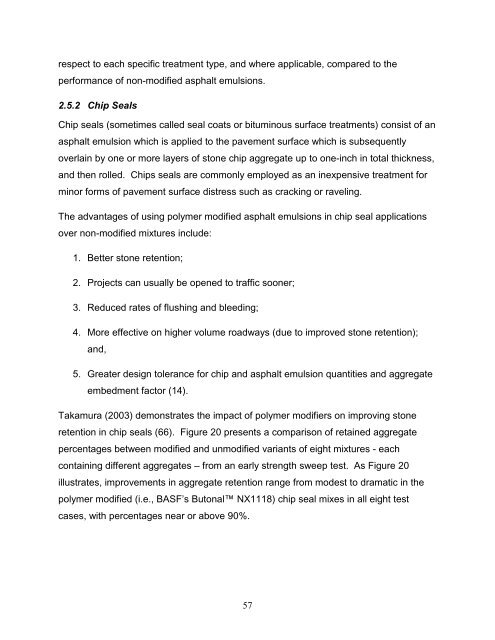Using Polymer Modified Asphalt Emulsions in Surface Treatments A ...
Using Polymer Modified Asphalt Emulsions in Surface Treatments A ...
Using Polymer Modified Asphalt Emulsions in Surface Treatments A ...
You also want an ePaper? Increase the reach of your titles
YUMPU automatically turns print PDFs into web optimized ePapers that Google loves.
espect to each specific treatment type, and where applicable, compared to the<br />
performance of non-modified asphalt emulsions.<br />
2.5.2 Chip Seals<br />
Chip seals (sometimes called seal coats or bitum<strong>in</strong>ous surface treatments) consist of an<br />
asphalt emulsion which is applied to the pavement surface which is subsequently<br />
overla<strong>in</strong> by one or more layers of stone chip aggregate up to one-<strong>in</strong>ch <strong>in</strong> total thickness,<br />
and then rolled. Chips seals are commonly employed as an <strong>in</strong>expensive treatment for<br />
m<strong>in</strong>or forms of pavement surface distress such as crack<strong>in</strong>g or ravel<strong>in</strong>g.<br />
The advantages of us<strong>in</strong>g polymer modified asphalt emulsions <strong>in</strong> chip seal applications<br />
over non-modified mixtures <strong>in</strong>clude:<br />
1. Better stone retention;<br />
2. Projects can usually be opened to traffic sooner;<br />
3. Reduced rates of flush<strong>in</strong>g and bleed<strong>in</strong>g;<br />
4. More effective on higher volume roadways (due to improved stone retention);<br />
and,<br />
5. Greater design tolerance for chip and asphalt emulsion quantities and aggregate<br />
embedment factor (14).<br />
Takamura (2003) demonstrates the impact of polymer modifiers on improv<strong>in</strong>g stone<br />
retention <strong>in</strong> chip seals (66). Figure 20 presents a comparison of reta<strong>in</strong>ed aggregate<br />
percentages between modified and unmodified variants of eight mixtures - each<br />
conta<strong>in</strong><strong>in</strong>g different aggregates – from an early strength sweep test. As Figure 20<br />
illustrates, improvements <strong>in</strong> aggregate retention range from modest to dramatic <strong>in</strong> the<br />
polymer modified (i.e., BASF’s Butonal NX1118) chip seal mixes <strong>in</strong> all eight test<br />
cases, with percentages near or above 90%.<br />
57
















